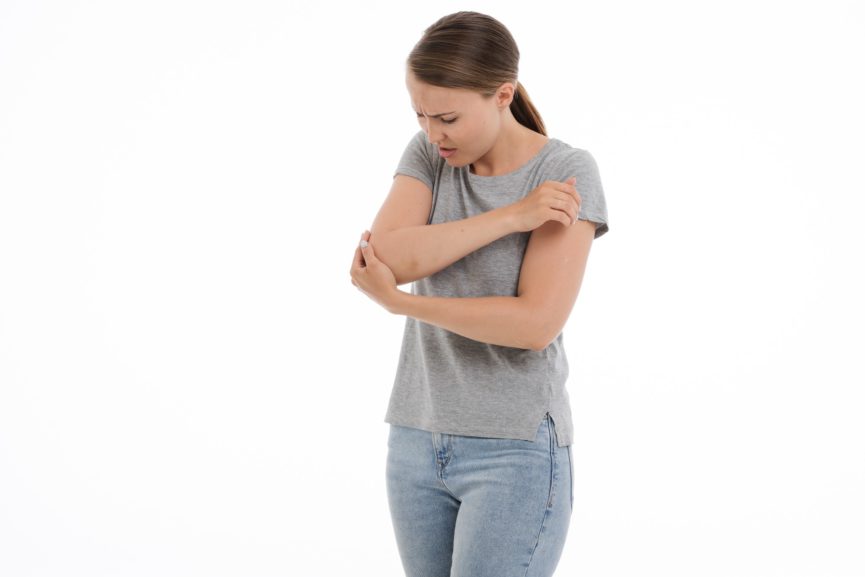Did you know you can get golfer’s elbow without ever touching a club?
Whether you’re at home out on the greens or at a desk, this common condition affects a large number of patients each year. As the name suggests, the elbow is the source of worry here: pain, weakness, and other symptoms can make you wonder what’s going on with your swing or grip. But how does golfer’s elbow happen?
If you’re dealing with pain from this condition or worrying about developing it, you should understand the common causes of golfer’s elbow, as well as how to identify it.
Causes of Golfer’s Elbow
Known as medial epicondylitis, golfer’s elbow happens when the muscles and tendons associated with the wrist and fingers are damaged. For most people, the damage occurs as a result of repetitive motions. As the name suggests, this is especially true for quick and powerful swings of the arm in the style of a golfer.
However, there are many activities that can put you at greater risk for golfer’s elbow. Any activities involving grasping and wrist flexion can put excess strain on the tendons and muscles.
Racket sports like tennis can hurt the arm when you use the wrong techniques. Using a racket that’s too light or heavy, having a powerful forehand with lots of topspin, and improper backhand technique can lead to damage.
Throwing sports, including football, javelin, baseball, softball, and archery, are common causes of golfer’s elbow as well. With these sports, an improper pitching technique can put too much strain on the muscles and tendons of the arm. Even with good pitching form, an excess of repetitive pitching motions over a short period can cause damage.
Weight training may be a surprising addition to this list. Where the damage in the activities above come from quick and forceful movements, the damage with weight training occurs when the muscles and tendons of the elbow are overloaded. This damage can worsen with improper lifting techniques.
Repetitive movements by vocation are worth considering as well. Construction workers, carpenters, painters, plumbers, and other manual laborers may find themselves complaining of this condition, for example. This is especially those who work in a field where grip strength and proper lifting are important.
Additional activities that include bending and straightening the elbow, like long periods of computer work, can also cause or contribute to golfer’s elbow.
Additional Risk Factors for Golfer’s Elbow
Golfer’s elbow can happen to anyone who meets the conditions above. However, there are a few risk factors that could increase your odds of developing the condition.
People age 40 or older see a greater risk of muscle and tendon damage in general than younger adults and children, for example. In addition, obese people are more likely to develop golfer’s elbow, as are smokers. As we noted above, of course, people who play specific sports or perform regular activities that put stress on the forearm are at higher risk as well.
If you receive a direct injury to the elbow, you may also be at greater risk of developing golfer’s elbow.
Golfer’s Elbow Symptoms
Now that you know the causes and risk factors associated with this condition, how can you identify it? A few common symptoms characterize golfer’s elbow, though they can vary from person to person. In addition, these symptoms can crop up all at once, or they can show up gradually over time, depending on the injury.
Soreness and pain are common symptoms, usually appearing on the inside of the elbow. This pain or tenderness may creep along the inside of the forearm as well. Your elbow may also feel stiff, or you may have numb or tingling sensations that radiate down into the fingers.
For some people, the simple act of making a fist can be painful, while others notice overbearing weakness in their wrist, elbow, hand, or fingers.
Note that all of these symptoms can worsen with certain movements. This is especially true of those that mimic the repetitive motion that caused the injury in the first place, like the swinging of a golf club.
Golfer’s Elbow Treatment
While there is no certain cure for golfer’s elbow, this condition often responds to basic medical treatment. You’ll want to work with a doctor or physical therapist to develop a treatment plan for your specific needs, but most plans will include a few basic steps to help you resume your active lifestyle.
The most important component of any recovery plan is rest. Avoid engaging in the activity causing you pain, as continuing the same motions can worsen the damage and lead to a difficult chronic injury. You may also want to wear a brace to support your elbow, taking some of the strain off of your muscles.
In the initial acute phase, applying cold therapy and compression wraps can help you manage your pain. After a few days to two weeks in, applying heat can stimulate blood flow and promote healing.
Your doctor may prescribe a course of NSAIDs (non-steroidal anti-inflammatory drugs) to help. Sports massages can help as well, and physical or occupational therapy can help you learn better form and the long-term techniques you’ll need to prevent the injury from recurring.
When these basic techniques prove ineffective, however, PRP therapy can help. This therapy is a promising option that helps damaged muscles and tendons regenerate, and it acts as a great alternative to therapy and long-term pain medications.
Book an Appointment for a Professional Evaluation
Get Regenerative Therapy for Golfer’s Elbow
Knowing the common causes of golfer’s elbow can help you prevent further pain, but it may not be enough to help you get rid of your existing symptoms.
If you’re ready to live pain-free, consider regenerative therapy for your golfer’s elbow, we’re happy to answer any questions you have, so contact us to learn how we can help you resume a normal lifestyle.

